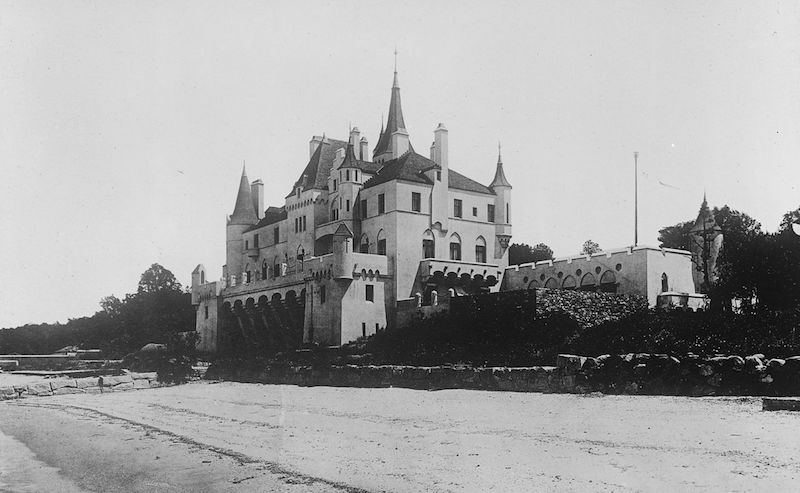New Film Shows How Art Brings Life to Green-Wood Cemetery
Discover how the living and the dead make Green-Wood Cemetery a vibrant part of NYCs cultural scene!

Yesterday, the VFX supervisor on the film The Great Gatsby released a composite “before and after” reel, showing the sheer amount of special effects it took to re-create the lavish world of F. Scott Fitzgerald’s beloved novel. The Bowery Boys previously dissected the trailer for architectural and historical accuracy last year, and today, we’re adding to the analysis of what’s real and what’s not.
The Great Gatsby takes place in 1922 and the film opens with a view of downtown Manhattan. Battery Park City wasn’t built until 1985, so the shape of the waterfront and the inclusion of piers are roughly correct, but Battery Park is shown much more lush than it was. Here’s a vintage photograph circa 1929:
At this level of resolution, it’s hard to analyze the buildings specifically, but the scale and placement of the buildings along State Street (the eastern border of Battery Park) seem a little off. State Street also wasn’t as angular of a street then as it is now, as you can see from the curvilinear border of Battery Park in the vintage photo.
The building featured in this shot is a clear homage to the Woolworth Building, and nearby City Hall. They’ve taken some creative liberties on the top of the building, from the color to the architecture of the spires, but it does capture one key thing about the Woolworth: the mass of the backside of the building was split into two, allowing light to enter down the middle.
Join us for an upcoming VIP tour of the off-limits Woolworth Building, led by the great granddaughter of building architect, Cass Gilbert;
VIP Tour of the Woolworth Building
The next shot that pans down from the top of the “Woolworth Building,” includes a building on the site of the City Hall Post Office and Courthouse that was demolished in 1939. However, the building in the film looks more like a commercial edifice than the French-style building designed by Alfred B. Mullet. Fun fact: As the main post office for the city, the building had pneumatic tubes!
In the trailer, The Bowery Boys and others noted the typo on the Ziegfield Follies sign in Times Square, which was corrected in the film. They also note another possible historical error: In 1922, the Follies performed at The New Amsterdam Theatre on 42nd Street, a few blocks away, but in 1921 they were “the Globe Theater on West 46th Street (today’s Lunt-Fontanne Theatre), quite close to this sign.” Whether the sign here was still there in 1922 still remains to be proven.
As the Bowery Boys pointed out, the skyscrapers seem to be a “composite view of various buildings of the age,” rather than an accurate placement. They report, “there are some vaguely Flatiron Building/Met Life Tower type structures, but they look like they’re on 42nd Street. And why do I think I can see something that clearly looks like the New York Central Building (later the Helmsley Building) which wasn’t finished until 1929?”
We could use some reader help on this one. We think this shot of Manhattan is oriented south, with a view of the Brooklyn and Manhattan bridges, and the skyscrapers in the Financial District. The New York Life Building, with the gold pyramid, is on the left, implying that the large skyscraper in the background is the Chrysler Building and the one under construction in the foreground is the Chrysler Building. But, construction on the Chrysler Building didn’t start until 1928, and the Empire State Building wasn’t until 1929. And the Chrysler Building is actually east of the Empire State.
Or is it a different skyscraper all together?
Based on the video, the scenes on the Queensborough Bridge and under the elevated trains were filmed in Sydney under the very recognizable Anzac Bridge.
While we’re focusing mostly on New York City locations in this piece, it’s worth noting that the Jay Gatsby House in the book and film was inspired by this crazy feudal-style castle called Beacon Towers, built by Mrs. Ava Vanderbilt Belmont in Sands Point. Fitzgerald writes in The Great Gatsby, that the house was a “colossal affair by any standard – it was a factual imitation of a Hôtel de Ville in Normandy, with a tower on one side.” Beacon Towers was bought in 1927 by William Randolph Hearst (who also built Hearst Castle in California) and demolished in 1945.

Image via Wikimedia Commons
Get in touch with the author @untappedmich. All film stills sourced from The Great Gatsby VFX from Chris Godfrey on Vimeo.
Subscribe to our newsletter